I really don’t mean to let this blog die, but with the new little girl around I’ve only had time to post over at my other project
You can catch me and many others over there for the near future. 🙂
I really don’t mean to let this blog die, but with the new little girl around I’ve only had time to post over at my other project
You can catch me and many others over there for the near future. 🙂
Posted in Uncategorized | Leave a Comment »
On September 17 2009, I welcomed my first baby into the world. I was either incredibly lucky that my labor lasted only nine hours or incredibly unlucky that my labor began at midnight with back to back contractions that didn’t let up for nine hours straight:) Either way, it was an incredible experience that began nine months prior.

Throughout my pregnancy and now with the little baby here, I have utilized so many of the plants I have come to know over the years. Many of them I used only topically, as so many herbs are contraindicated for pregnancy. But here is a list of the plants and preparations that I found indispensable throughout this process.
Pregnancy
Nettles– This plant seems to come up often for possible treatment of so many ailments in herbal medicine, and I certainly found it essential for my pregnancy. I opted not to take prenatal vitamins and instead drank a daily infusion of nettles and thimble berry leaves.
Nettle’s nutritional and medicinal qualities are well known to many but I thought I would detail a bit of what it can do specifically for the pregnant woman. Nettles contain large amounts of calcium, iron,sulphur, phosphorus, and potassium as well as vitamins A, C, D, and K. Taken as an infusion throughout pregnancy, nettle can help reduce or eliminate leg cramps and muscle spasms and ease the pain during and after child birth. It is high in absorb-able mineral salts, including calcium which helps with leg and uterine pains.
It is famous as a tonic for the urinary tract, and while many women suffer from UTI’s while pregnant a stiff decoction can help flush out the marauding, painful bacteria. A pregnant woman also has 50% more blood circulating through her body than she did before pregnancy and therefor her kidneys are working 50% harder. Nettle’s help keeping the kidneys healthy is a boon to any pregnant women.
Vitamin K shots are often given to newborns to prevent internal bleeding, drinking or eating large amounts of nettles in the last month of pregnancy can help ensure that there is already ample vitamin K in the blood stream eliminating the need for supplementation and the concer of potential bleeding.
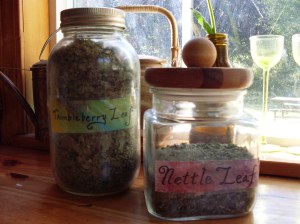
Thimble berry (wild raspberry) Leaves– Thimble berry grows in dense thickets around my land, and after finding that it can be used interchangeably with Red Raspberry leaf for pregnancy, I opted to use it. I collected and dried many basketfuls of this herb. Raspberry leaf has a long tradition of being used for pregnant women. Known as a “birth herb” it is a uterine tonic that both relaxes the uterus and tones it for the work of expanding and then contracting. Raspberry leaf is rich in vitamins including C, A, B1, B3 and E. Taken as an infusion, it is also useful in the postpartum period to help increase milk production and ease uterine cramping.
Comfrey– The only other plant I was really able to utilize during my pregnancy was comfrey in the form of a topical cream to help prevent stretch marks. Comfrey is soothing, relaxing and healing to the skin, it contains allantoin which is a cell proliferater and tissue healing agent perfect for rapidly stretching skin. I did not end up with any stretch marks, and whether that is due to the skin healing properties of comfrey or my own genetics I can’t say, but I will definitely use it again. I also found another use for this cream by accident. After spreading the cream on my belly I would rub the excess into my face. I was struggling with some hormonal acne and as long as I put the comfrey cream on my face the acne seemingly disappeared.
Labor and Postpartum
I had on hand a few herbs to use during labor. In my case I didn’t end up needing them, but I thought I would list them anyway.
Labor Enhancer Tincture– I made a simple tincture of equal parts Blue Cohosh, Black Cohosh and Trillium Root. However my labor progressed so fast that the idea of enhancing it seemed ludicrous. Unfortunately, blue and black cohosh do not grow in my area so I relied on dried herbs for the tincture. However, trillium does grow here. According to Micheal Moore, dried trillium root offers little more than nutrition and therefor is not recommended for use. The plant also has a slow and tenuous growing cycle and is becoming ever more limited in its growing area therefore wasting the dried herb seems unethical. I live in the woods and was able to find a large stand where I harvested but one root and tinctured it in a very small amount of alcohol. Seeing as I was only hoping to use it once, I certainly did not need much. All three of these herbs promote uterine contractions, this can be very useful in the event of stalled labor. If you are having and out of hospital birth, a tincture like this can come in very handy if your labor is not progressing and you are being threatened with hospital transfer.
Shepard’s Purse Tincture– Shepard’s purse is commonly used to stop bleeding or hemorrhaging, particularly from the uterus. It is a hemostatic herb, meaning that it works as an internal astringent to stop bleeding. The herb works so well that one midwife tried giving the herb preventively only to find that the afterbirth was heavily clotted and did not pass easily. I had this herb on hand just in case. I didn’t expect to use it but thought I would rather be safe than sorry. I also did not end up needing it’s assistance. My uterus was just as anxious to contract as it was to labor 🙂
Motherwort– Beginning at 36 weeks gestation , I began taking a half dropperful of motherwort daily. I had a wonderful pregnancy but was beginning to find those final weeks a little tiring. Motherwort has calming and mildly sedative properties owed to the presence of bitter glycosides that are beneficial in treating the anxiety and trauma related to ensuing child birth. It also helps prepare the uterus for the upcoming birth. While it is considered safe for the final weeks it is definitely not recommend to be taken before.
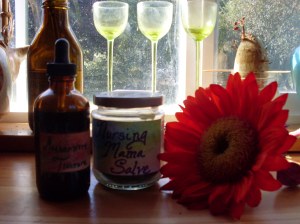
I also have found it indispensable for these postpartum weeks when the hormonal changes that inevitability ensue after birth began to take hold and nights of diminished sleep began to add up. A dropperful a day of this plant has certainly kept my nerves from getting frayed and allowed me to continue to enjoy this experience.
Mastitis– It has only been three weeks that I have been a mom, but in this time I have had or been threatened with 4 cases of mastitis. The first two times I was unprepared and spent a grueling day with flu like symptoms, painful breasts and a high fever. After a few Internet searches I found there were two schools of thought in terms of treatment. The common choices seemed to be to take antibiotics or to put a cabbage leaf on your breast. I chose the cabbage leaf. The first time I used it, I went to bed with a fever and very sore breasts, 4 hours later I woke up to feed the baby and the fever had broken and the pain in my breasts had gone away. Since then I have also started taking a tincture of Echinacea when I feel those first electrical like pains in my breasts and that seems to have kept it at bay since.
Nipplewort– This plant grows profusely in my garden. My local field guide describes it as a plant that was traditionally used to treat sore nipples. The french name is herbs aux mamelles, indicating its traditional use for treatment of cracked or ulcerated breasts. What is strange is that is all the information I could find on this plant, perusal of all my herbals and extensive Internet searches turned up no information on it use for treating sore nipples. Despite the lack of information I infused the leaves of this plant in olive oil early this summer. I made a salve with it by adding a bit of beeswax and equal parts pure lanolin and infused oil. From the day the baby was born I applied this directly to my nipples after each feeding. My breasts still ached, cracked and blistered, but after only six days of breast feeding they were fine and feedings became painless. This seems awfully fast in comparison with other mothers who claim it took least two weeks and up to three months for the pain to cease. Maybe its time this plant was reintroduced to the postpartum world!
Baby
Whenever possible I want to avoid using chemicals or drugs on me or on this new little baby. In that vain, I created a few products to help her little bottom.
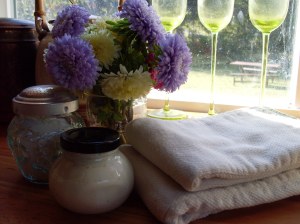
I read so many rave reviews of Weleda’s diaper rash cream. After reading the label I decided that I could make a similar cream and save the money. I can say in our short three weeks together, I have only noticed a sign of diaper rash twice, and each time it was gone at the next changing after applying this cream.
Diaper Rash Cream
3/4 cup Sweet Almond Oil infused with Calendula and Chamomile
1/3 cup Coconut Oil
3/4 oz beeswax
Melt these ingredients on the stove top, cool to room temperature in a bowl.
With a stick blender, mix
3/4 cups Aloe Vera Juice
Pour into containers and use whenever there is a sign of rash.
The last item I’ve used is a simple baby powder. Avoid using talc on the little ones, its is similar in composition to asbestos and has been linked with lung cancer. Commercial powders are also full of fragrances that should be avoided.
Baby Powder
1 cup Cornstarch or Arrowroot Powder
2 Tbls. Betonite Clay
2 Tbls. Kaolin Clay
1/4 cup Lavender Flowers
Grind the lavender flowers in a blender or coffee grinder and run through a sieve to winnow out any big pieces. Combine ingredients and mix. Apply to baby’s diaper as needed.
I hope this might help a few of you out there. My pregnancy was really a delight, my labor ( though intense) couldn’t have been better, and my baby is a dream. I really do feel that I owe much of the ease of the entire experience to the plants that helped me through it.
Posted in Uncategorized | 1 Comment »
I still get overwhelmed by the beauty and abundance of the place we live. Berries and fruit grow and blanket the countryside. My garden produces without much assistance from me. The rivers run through the highlands and valleys from glacial run off that I see as 40 cascading waterfalls that pour over the rocky surface of Whitehorse Mountain.
We’ve been celebrating the harvest season by putting up so many different types of preserves. I’ve been canning and pickling. I’ve made Dylan’s Mother’s relish, a sweetish summer squash and pepper pickle, dilled green beans, Oregon grape jelly and am trying out a refrigerator pickle recipe. And there is still so much more to can.
This weekend we dedicated to making wines and ciders. I suppose these drinks would all be classified as country wines. Dylan kept telling people that we were gathering nature’s bounty and making it into booze. He does have a way with words:)
We made five varieties and still have two more to make, Blackberry and Elderberry. Expect gifts of homemade wine in a year or so.
We began the process by scoping out feral apple trees that grow along the Stilliguamish river valley and drove around and knocked on peoples doors or walked down overgrown pathways and picked apples that were just going to fall back to the ground. The weather has certainly changed this week and though it is yet August the cardinal call of Fall could be felt all through the air.
We also harvested pounds of blackberries from our own blackberry “orchards,” and Asian Pears from our very own tree. The real adventure came from driving way up Sauk Mountain and harvesting wild mountain highbush blueberries from stands that were as tall as me and blanketed the mountainside. It was amazing to notice that within a stand grew at least tree different varieties of berries, one of which had an interesting but notable taste of meat at the beginning, Dylan dubbed them Meatberries.
We gathered all of our fruity bounty and began pressing the fruit in the press we rented for 15 dollars a day from the local homebrew store. The brews that came out of the process were Apple Cider, Asian Pear and Highbush Blueberry Wine, Plum Wine, Plum Lavender Wine, And Plum blackberry Wine.
I will finish off the recipes I used and post them soon. Of course it will be a year before we will know what they taste like, but I am sure that all the love and time we put into them will make the wait worth while. And besides, next year we will be apple to sip on the product as we make more.
Here’s to a wonderful harvest season.
Posted in Uncategorized | 8 Comments »
I have been so bad about my blog. Though my pregnancy has been quite easy I do have a bad case of placenta brain and can’t seem to pull together thoughts or form sentences very easily. But I have been doing so many wonderful things with plants and homesteading. I promise to write more on the subject soon but until then I leave you with a video my husband made of us on our recent vacation.
Posted in Uncategorized | 1 Comment »
Beltane came and went a week ago. The weather was warm and I spent the day outside absorbing the sun and heat. I layed on the grass and exposed my growing belly to the sun and watched the chickens and ducks peck at the ground, and happily gazed at my bewildered cats as they roamed amongst the birds that are too big for them to eat. Even Magdalene, the skittish leghorn relaxed in the sun.
As if on cue the dandelions in my yard really burst on beltane. I had been waiting for the many plants to bloom in numbers before harvesting the flowering tops to make wine out of them. The yard was awash in yellow and in the warmth of the midday sun I wandered the outside picking basketfuls of yellow miracles for wine and unopened buds to pickle.
I have never made dandelion wine before so, truly, this is an experiement and I hope that a year of maturing the brew will pay off.
The recipe I used is as follows
Pick the flowers and bring into the kitchen. Set one gallon of water to boil. While it heats up to a boil, remove as much of the green material from the flower heads leaving only petals. Pour the boiling water over the flowers, cover with cloth, and leave to steep for two days. Do not exceed two days. Pour the mixture back into a pot and bring to a boil. Add the peelings from the four oranges ( no white pith) and boil for ten minutes. Strain through a muslin cloth or bag onto a crock or plastic pail containing the sugar, stirring to dissolve. When cool, add the juice of the oranges, the yeast and yeast nutrient. Pour into secondary fermentation vessel, fit fermentation trap, and allow to ferment completely. Rack and bottle when wine clears and again when no more lees form for 60 days. Allow it to age six months in the bottle before tasting, but a year will improve it vastly.
I only added a bit of Cuvee yeast I had on hand and not the nutrient. And for fermentaion bottles I poured the liquid into two seperate gallon milk type jugs and fit a ballon over the top that I had poked holes in with a needle for my fermentation trap. The wine is sitting in a dark place marked and dated. I’ll wait a couple of monthes before bottling and come next mayday I will celebrate with a bottle of dandelion wine and another day in the sun surrounded by yellow flowers.
Posted in Uncategorized | 2 Comments »
The sun has come out and my shoulders and back are even a touch sunburned. We spent the weekend outdoors building and mending and attempting to bring this land back from disrepair. The weather has warmed significantly and so the garden is our first priority. We have decided only to fence for rabbits and to keep the chickens out as we have never seen even one deer down in the valley. A fence then requires a gate. One of the few good things about living on a piece of land that the previous owners used as a home and a dump is all of the things you can scavenge to build with. I searched the land and found all of these goodies and built two fabulous garden gates.
and…
Of course the view is slightly impaired by the hulking metal monstrosity behind it. That beautiful “shop” came with the house and is awaiting demolition to be sold as scrap. It is huge and we do not need a wood mill. Ironically, most people that have visited our land seem more excited about the shed then the mountains. People have pleaded with us not to dismantle it but despite all of the wonderful ideas of uses including a dance hall, an indoor basketball court, my stained glass studio, and my personal favorite-using it to store other people’s crap in, we are going to remove it. Anyhow, hopefully in future shots you will see nothing but the trees that surround the creek.
Last week I made another meal out of our bounty of wild elk meat and included some wild crafted jelly I made last fall. The recipe follows
Elk Tenderloin Steaks with Elderberry Pan Sauce
Sauce
Heat a cast iron skillet to medium-high heat. After the steaks are sliced, tenderize them a bit with a mallet to make them a bit larger. Crush garlic and rub steaks with garlic and salt and pepper. Pan fry with a little oil about 3 minutes on each side until medium rare. Set steaks aside and cover, they will continue cooking to medium.
Add more oil to skillet and saute mushrooms until soft. Add capers, jelly, mustard, rosemary and juices from the steaks or a little water if the sauce is too thick. Finish sauce by stirring butter into to sauce and serve immediately over steak.
We loved this recipe, I ended up cooking the elk this way simply because the tenderloin was in all sorts of weird pieces and this was the only way I could think to save it. It ended up being incredibly tender and my favorite way to eat tenderloin now. The wild bite of the sauce was a perfect accompaniment to the wild meat.
Posted in Uncategorized | 2 Comments »
Outside it is raining, the rain falls gently as it does in the PNW. We had many days of sun and small leaves are finally beginning to show themselves on some of the trees. Easter was spent camping on the East side in a canyon outside Wenatchee. I brought two dozen eggs from the hens and attempted some natural dying, and ended up witheggs colored slate from elderberries, brown from rosehips, yellow-green from usnea lichen and grass, and orange from onion skins and oregon grape root. Rewilded Easter colors I guess. 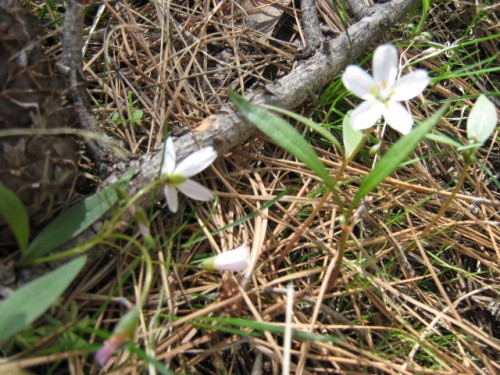 We munched on the fresh green shoots of cattails and dug the corms of the purslane family flower Western Spring Beauty.
We munched on the fresh green shoots of cattails and dug the corms of the purslane family flower Western Spring Beauty. 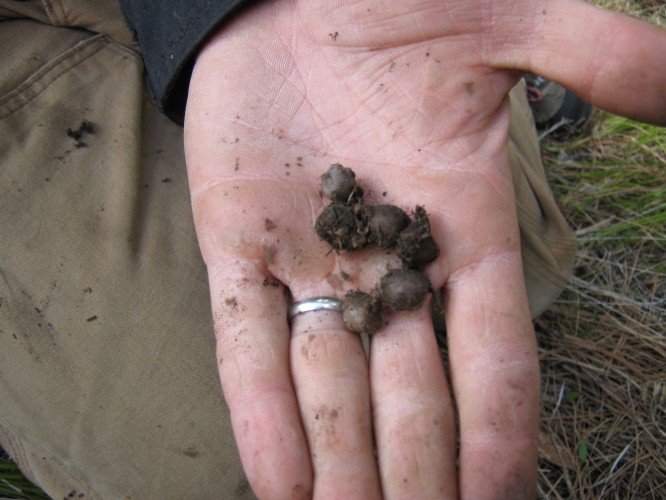 Vesla’s dog was is heaven after finding and burying four different deer legs.
Vesla’s dog was is heaven after finding and burying four different deer legs.
Saturday evening we were startled by a herd of 20 or so deer that sneeked up near our camp and in the night I woke to the sound of hoof after hoof making its way to the waterhole near our tent. My happiness at living in this part of the world is constantly reinforced when I take weekend trips. It is amazing how much diversity in ecosystems there are within this small state. On just a short weekend trip I can travel the lush rainforesty coastal side and then go through high dessert forests, down to dry river canyons with big horn sheep and rolling sagebrush hills. 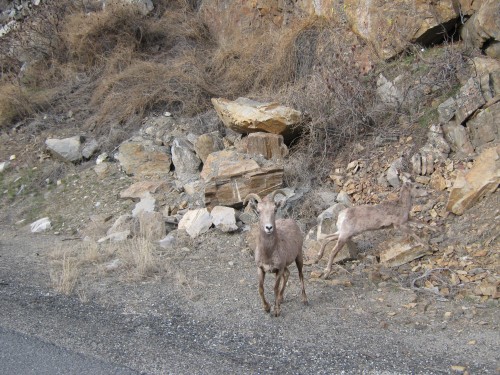 The draw that I’ve always felt to New Mexico is easily quelled by a short trip to the dry side of the mountains. And despite the range of beautiful things I see around the area my heart is always eased as I recross the pass and waterfalls cascade all around and green is the only color you see. When ever I come home Iam reminded how the these mountains really could only be called the Cascades.
The draw that I’ve always felt to New Mexico is easily quelled by a short trip to the dry side of the mountains. And despite the range of beautiful things I see around the area my heart is always eased as I recross the pass and waterfalls cascade all around and green is the only color you see. When ever I come home Iam reminded how the these mountains really could only be called the Cascades.
The baby kicks inside of me and there is much work to be done around the homestead, I am grateful the kitties are as sleepy as I am and I watch as spring comes, slowly.
Posted in Uncategorized | Leave a Comment »
While many of you may have already had your fill of nettles this year, up here at my little magical end of the Stillaguamish river valley, the bounty has just begun. There are little pockets of emerald rosettes emerging from all around the creeks edges and blanketing the ground beneath the fir forests. They come up out of the ground looking like plump, puckered red lips. Little spring kisses from the earth.
I am now entering my 17th week of pregnancy, my tummy is beginning to protrude and so much of the first trimesters ailments have happily passed. I have opted not to take pre-natal vitamins, for many reasons that I won’t list here, but I know I need to supplement my diet to ensure that I get all the nutrition I need. Its funny because in this case its me I need to worry about, this little baby will get all it needs and then leave whatever is left to me, so to make sure I fair well good nutrition is very important.
Of course Nettle’s nutritional and medicinal qualities are well known to many but I thought I would detail a bit of what it can do specifically for the pregnant woman. Nettles contain large amounts of calcium, iron,sulphur, phosphorus, and potassium as well as vitamins A, C, D, and K. Taken as an infusion throughout pregnancy, nettle can help reduce or eliminate leg cramps and muscle spasms and ease the pain during and after child birth. It is high in absorb-able mineral salts, including calcium which helps with leg and uterine pains.
It is famous as a tonic for the urinary tract, and while many women suffer from infections of the urinary tract while pregnant a stiff decoction can help flush out the marauding painful bacteria. A pregnant woman also has 50% more blood circulating through her body than she did before pregnancy and therefor her kidneys are working 50% harder. Nettle’s help in keeping the the kidneys healthy is a boon to any pregnant women.
In a hospital birth vitamin K shots are often given to newborns to prevent internal bleeding, drinking or eating large amounts of nettles in the last month of pregnancy can help ensure that there is already ample vitamin K in the blood stream eliminating the need for supplementation and the fear of bleeding.
I drink an infusion almost daily and supplement my meals with the fresh plant to help get all the nourishment I can from these beautiful plants. Last night I made a feast of stewed lamb with nettle and peaches with a side of nettle yogurt dip. The recipe is as follows but be sure to improvise to your own tastes as I do. Enjoy the bounty and eat your weeds!
Stewed Spiced Lamb with Nettles and Peaches
In large heavy duty dutch oven heat 3 tbsp olive oil, put lamb into pot and brown on all sides. Once browned add onions and cook until slightly wilted. Crush spices in mortar and pestle and add to pot along with cinnamon, garlic, ginger and pepper. Cook 2 minutes. Deglaze the pot with vinegar and cover with water one inch above the meat. Bring to boil, cover, cook for one hour, add peaches and nettles and cook uncovered for 30 minutes or until the water has mostly evaporated, serve with yogurt sauce and fresh vegtables.
Nettle Dip
Lightly brown garlic in a heated skillet with 1 tbsp olive oil, once browned add nettles and 1/4 cup of water and sautee until well cooked, about 5 minutes. Remove from heat and let cool to room temp. In a food processor add all ingerdients and pulse until thouroughly mixed. Remove from food processor and stir in jicima, chill and serve as a sauce for meats, a dip, or a delicious salad dressing.
Posted in Uncategorized | Leave a Comment »
Oh what weather we have been having. days of glorious sun, warmth, spring emerging.
To take advantage of the weather, Dylan and I decided to cook outside over the fire. We sipped lemonade and I satisfied my pregnancy related need for steak.
One of my favorite things to do when cooking over a fire is to cook vegetables directly in the coals, not wrapped in tinfoil or a leaf, but just dropped right in the mix of the flame.
We have only begun to be able to work the outside area of the land and have not built our permanent fire pit yet so we made a fire in a metal fire pit someone gave us when we still lived in the city.
The first thing to do is to build a base that will provide you with alot of coals and still keep the fire going. Move aside a pile of coals near the flames but big enough that the vegetables can lay flat and get good contact with the heat.
I’m not sure that every vegetable would be appropriate for this sort of cooking, I used an eggplant, zucchini, a red pepper and two jalapenos. The skin is going to get very charred so it would be best to use vegetables that have some sort of outer covering that can be scraped off.
Lay the veg directly on the coal and turn as each side is charred, make sure it is pitch colored before removing it. Place the veg under a bowl and let it cool there to help cook it all the way through.
With a pairing knife begin peeling or scraping blackened skin off the vegetable. You will not be able to get every little fleck so don’t try.
I then chopped them up and added fresh rosemary, a little butter and olive oil and a touch of yogurt and salt. Voila, we had our smokey side to accompany our steaks. I used the leftovers in a hummus I made the next day for lunch and in the past I have added the roasted vegetables to soups. Mmmmmm!
Posted in Uncategorized | 1 Comment »
We are all longing to go home to some place we have never been – a place half-remembered and half-envisioned we can only catch glimpses of from time to time. Community. Somewhere, there are people to whom we can speak with passion without having the words catch in our throats. Somewhere a circle of hands will open to receive us, eyes will light up as we enter, voices will celebrate with us whenever we come into our own power. Community means strength that joins our strength to do the work that needs to be done. Arms to hold us when we falter. A circle of healing. A circle of friends. Someplace where we can be free.
“Oregon Grape is the long road home, not a short-cut to bliss.”
Yesterday I harvested Oregon Grape for the first time. Though I have seen the plant for years, and knew of it many uses I never felt drawn to it. But yesterday with a small group of other women I did it. The experience was overwhelming, Where should I start?
I have a long standing bad habit of jumping out of the present and analyzing my every word and interaction, especially with people I am just getting to know. I tend to batter myself if I don’t say exactly what I mean, or if I am misunderstood a small part of me panics. This is not an overwhelming habit but a subtle and useless one nonetheless. Surprisingly, that part of me was silenced yesterday and something entirely different took me.
Posted in Uncategorized | 2 Comments »